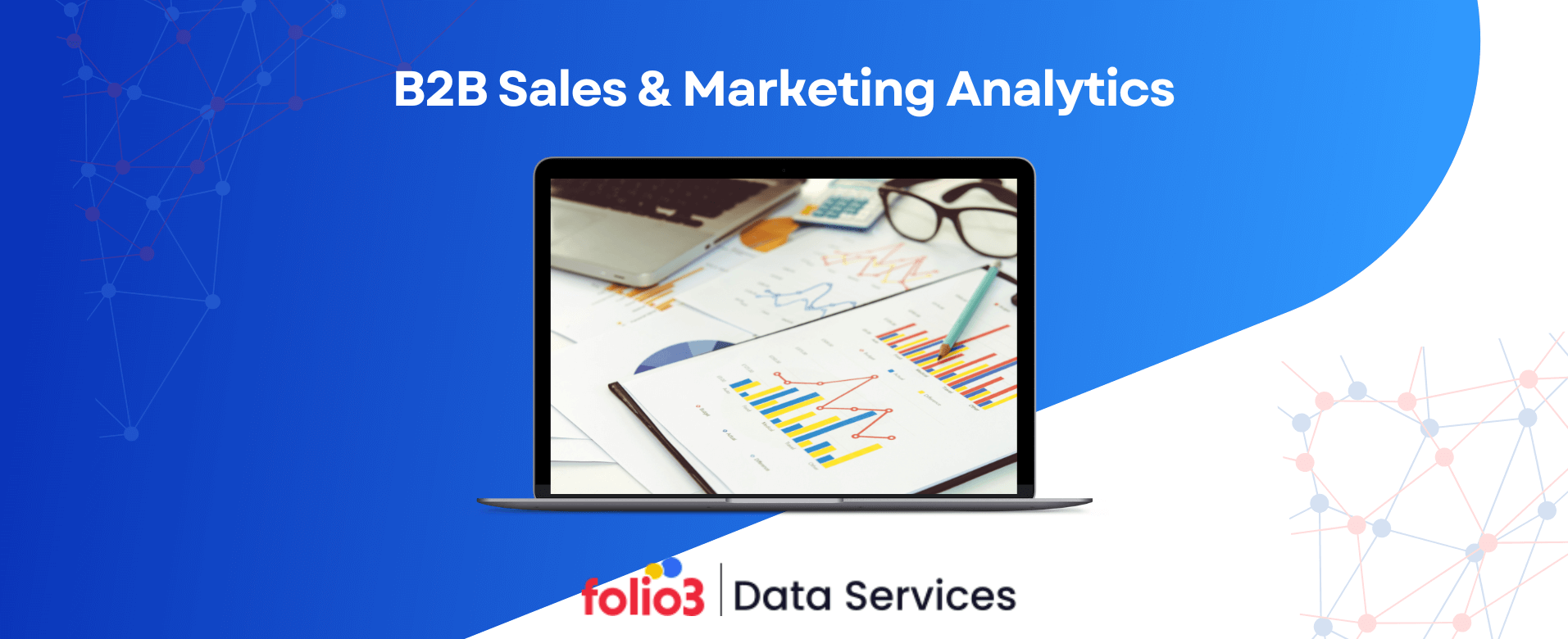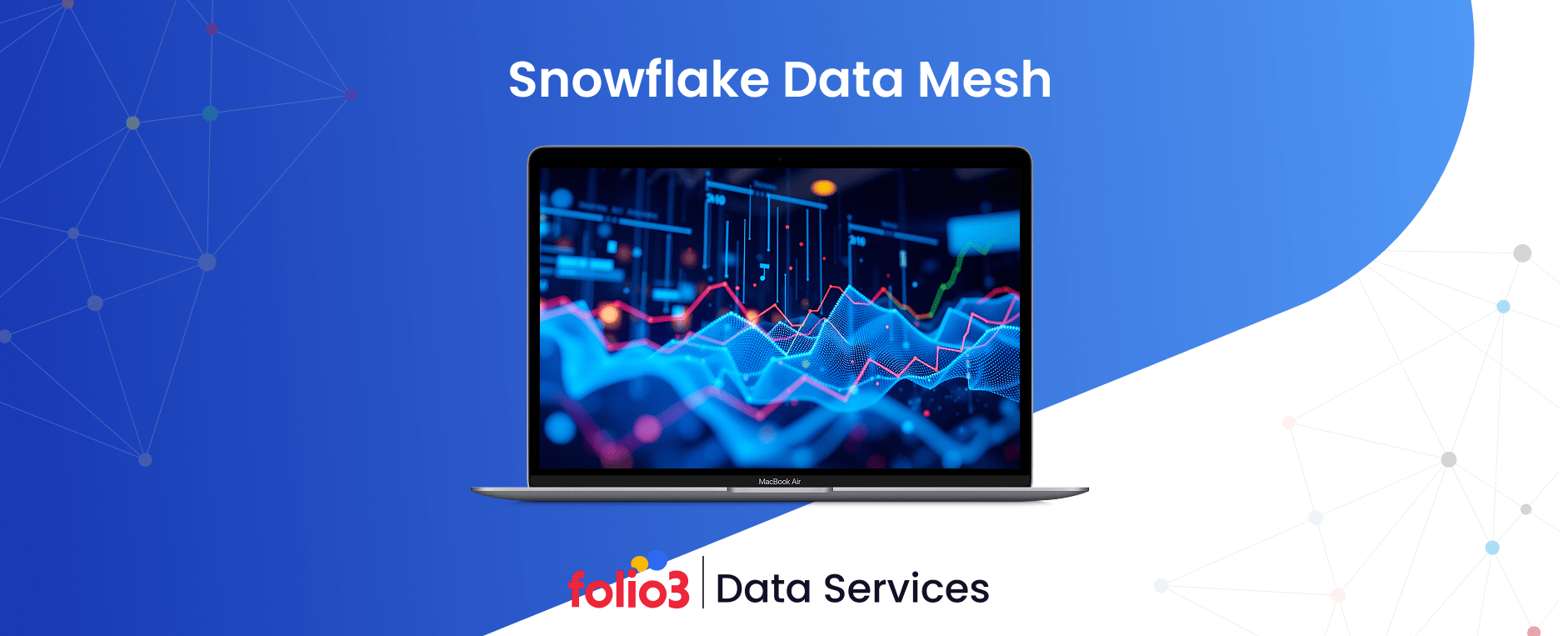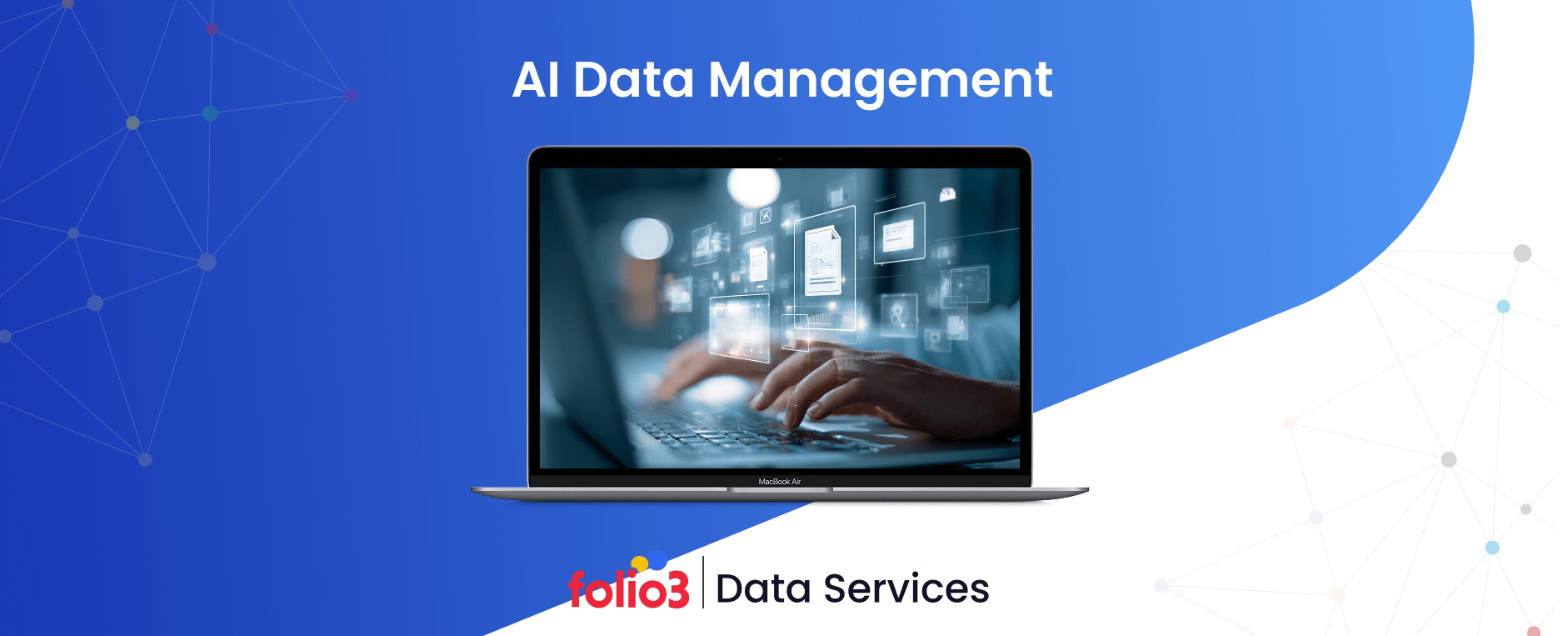For B2B (Business-to-Business) organizations, the ability to analyze and interpret data is no longer just a competitive advantage but a necessity. B2B analytics provides the insights to drive strategic decision-making, optimize marketing and sales efforts, enhance customer relationships, and streamline operations.
Data-driven decision-making is at the heart of successful B2B organizations. Data analytics allows companies to make informed decisions based on real-time insights rather than relying on intuition or outdated information. This approach improves accuracy and helps identify growth opportunities, manage risks, and optimize operational efficiency.
For B2B businesses, using analytics effectively means gaining deeper insights into customer behavior, understanding market trends, improving sales performance, and refining marketing strategies. The power of B2B analytics lies in its ability to turn complex data sets into clear, actionable insights that drive business growth.
B2B analytics offers numerous benefits, including enhanced decision-making by providing data-backed insights that minimize risks. It helps improve customer relationships by better understanding customer behavior and preferences. Analytics also boosts operational efficiency by identifying process inefficiencies while optimizing marketing and sales strategies for greater effectiveness.
This blog delves into the significance of B2B analytics, the trends shaping this field, and how businesses can use analytics to transform data into actionable insights.
What is B2B Analytics?
B2B analytics uses data to generate insights that help improve decision-making within B2B organizations. These insights can be used across various functions, such as marketing, sales, operations, and customer service.
B2B analytics can be categorized into several types, including:
- Descriptive Analytics: Analyzes historical data to understand past performance.
- Diagnostic Analytics: Helps understand the reasons behind specific outcomes.
- Predictive Analytics: Uses data to predict future trends and behaviors.
- Prescriptive Analytics: Provides recommendations for future actions based on data insights.
The Power of B2B Analytics
Let’s explore the key ways in which B2B analytics is transforming business operations:
1. Driving Data-Driven Decision Making
From financial performance to customer preferences, these insights empower companies to make smarter, faster decisions without relying on gut feelings or assumptions.
2. Enhancing Customer Relationships
B2B companies can leverage customer analytics consulting to understand their customers better. By analyzing customer data, businesses can uncover patterns in behavior, preferences, and needs, enabling them to deliver personalized experiences, predict customer needs, and improve retention.
3. Optimizing Marketing and Sales Efforts
B2B analytics helps businesses optimize marketing and sales strategies by providing insights into customer segmentation, campaign performance, and sales funnels. With the help of customer experience analytics, companies can better understand buyer interactions across touchpoints, enabling them to allocate resources more effectively and achieve higher ROI by focusing on strategies that drive the best results.
4. Streamlining Operations and Processes
Analytics identifies bottlenecks in operations, helping companies streamline processes and reduce inefficiencies. This can lead to significant cost savings, improved productivity, and a better customer experience.
5. Forecasting and Future Planning
Predictive analytics allows B2B businesses to forecast future trends and customer behaviors. By leveraging advanced predictive analytics techniques, companies gain the foresight needed to plan strategically—whether expanding into new markets or adjusting their product offerings based on anticipated demand.
Let’s work together to turn your data into powerful insights that drive success.
Optimizing B2B Marketing Through Analytics
B2B analytics transform marketing strategies by providing valuable insights into customer behavior, preferences, and engagement. By using data, businesses can create highly targeted marketing campaigns, refine their account-based marketing (ABM) strategies, and improve their lead-generation efforts.
This section will explore how B2B analytics can enhance marketing efforts, driving better results and stronger customer relationships.
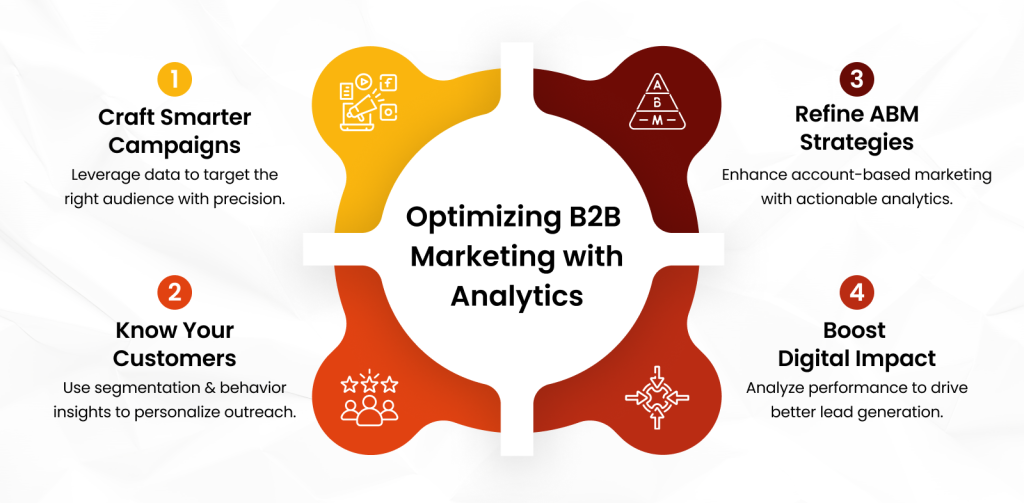
Importance of Analytics in Crafting Targeted Marketing Campaigns
B2B marketing requires a deep understanding of customer needs and pain points. B2B marketing analytics can help businesses segment their audience more effectively, ensuring marketing efforts are targeted and relevant. When supported by a strong customer data strategy, this approach reduces marketing spending while increasing engagement and conversion rates.
Using Customer Segmentation and Behavior Analysis
Customer segmentation is a powerful tool in B2B marketing. By leveraging B2B marketing analytics tools, businesses can analyze customer behavior and demographics to create highly targeted marketing campaigns. For example, a software company might segment its audience into industries, company sizes, or stages of the buying journey, tailoring its marketing messages accordingly.
Insights into Digital Marketing Performance and Improving Lead Generation
B2B analytics plays a crucial role in digital transformation by providing insights into the performance of digital marketing efforts, such as email campaigns, social media ads, and SEO strategies. By analyzing metrics like click-through rates, conversion rates, and lead generation, businesses can refine their approach to generate more qualified leads and improve ROI, enabling them to stay competitive in a data-driven world.
Role of Analytics in Refining ABM Strategies
Account-Based Marketing (ABM) is a key strategy for B2B companies targeting high-value clients. Analytics helps businesses identify the most promising accounts, tailor their messaging, and measure the success of ABM campaigns. By aligning marketing efforts with the needs of specific accounts, businesses can improve their sales pipeline and close rates.
B2B Sales Performance Analytics
Sales performance in B2B organizations can be significantly enhanced through analytics. By using data to track sales pipelines, measure team performance, and identify bottlenecks, businesses can optimize their sales efforts for better outcomes.
This section will explore how B2B analytics can improve sales strategies, boost revenue growth, and help businesses make informed decisions to drive success.
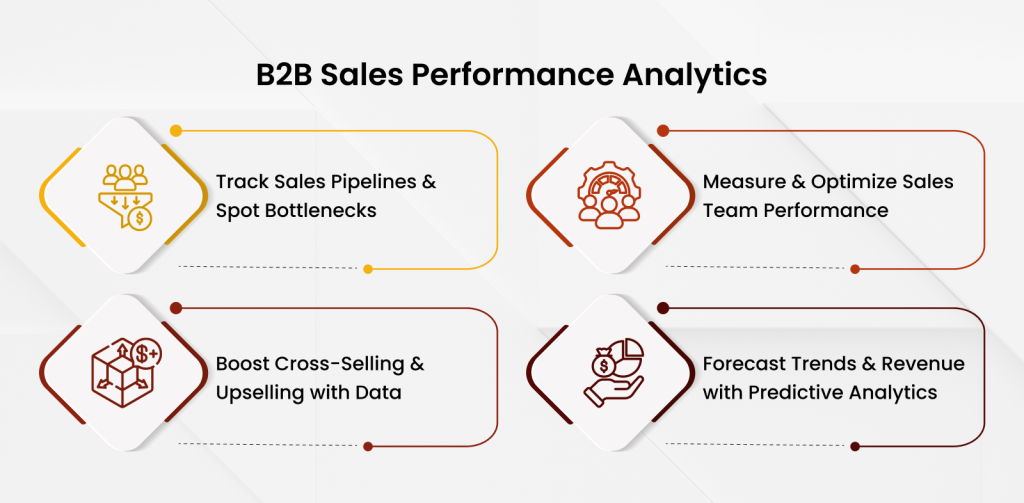
Monitoring Sales Pipelines and Identifying Bottlenecks
B2B sales analytics provides visibility into the entire sales pipeline, helping businesses identify where deals are stuck. This insight enables sales teams to move deals forward and proactively improve conversion rates.
Measuring Sales Team Performance and Optimizing Efforts
Analytics helps businesses assess the performance of their sales teams by tracking key metrics such as win rates, sales cycle length, and average deal size. These insights can be used to identify areas of improvement, optimize sales strategies, and allocate resources effectively.
Analytics-Driven Strategies for Cross-Selling and Upselling
Sales performance in B2B organizations can be significantly enhanced through analytics. By using data to track sales pipelines, measure team performance, and identify bottlenecks, businesses can optimize their sales efforts for better outcomes. Partnering with providers of data strategy services can further strengthen these efforts by ensuring the right data infrastructure and governance are in place to support scalable analytics initiatives.
Using Predictive Analytics to Forecast Sales Trends and Revenue Growth
Predictive analytics enables B2B companies to forecast future sales trends based on historical data. By staying aligned with emerging data analytics trends and understanding the factors that drive sales growth, businesses can adjust their strategies to capitalize on these trends and maximize revenue.
Key Components of a Robust B2B Analytics Strategy
To effectively use B2B analytics, businesses need a strong data analytics strategy. Here are the key components:
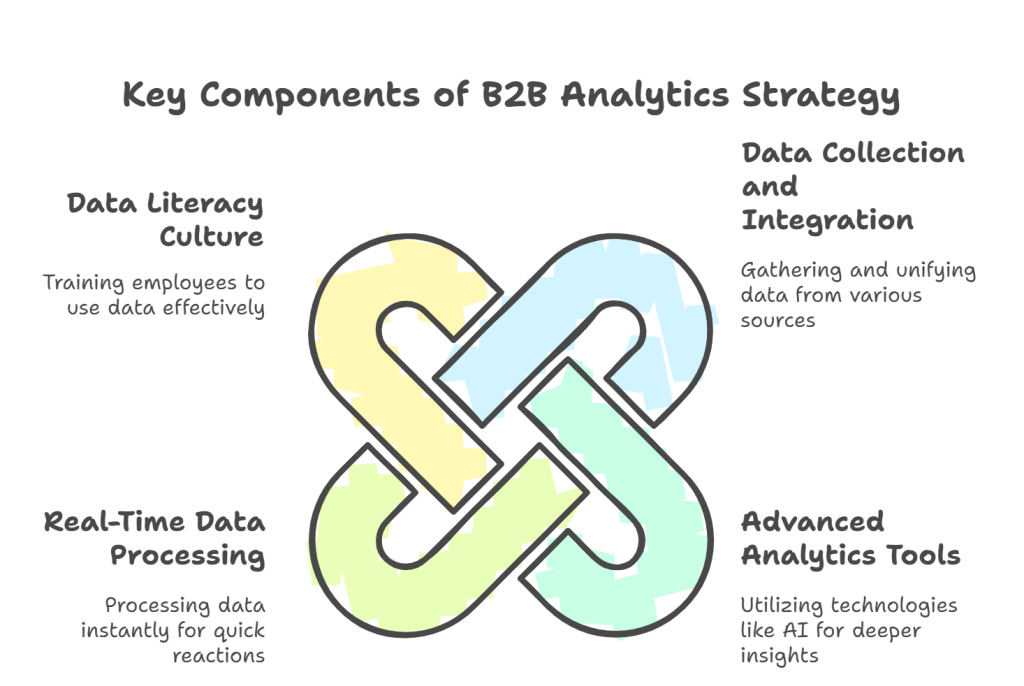
1. Data Collection and Integration from Multiple Sources
Collecting data from various sources—such as CRM systems, marketing platforms, and social media—is crucial for a comprehensive analysis. Effective customer data integration, supported by modern integration tools, helps combine this data into a unified view, providing a clearer picture of customer behavior and business performance.
2. Advanced Analytics Tools and Technologies
Advanced analytics tools like machine learning and AI help businesses extract deeper insights from data. These technologies can analyze large data sets in real-time, enabling businesses to make faster, more informed decisions.
3. Importance of Real-Time Data Processing and Visualization
Real-time data processing allows businesses to react quickly to market or customer behavior changes. The benefits of real-time analytics become clear when B2B customer analytics is combined with visualization tools such as dashboards, providing a clear and actionable overview of key metrics. This makes it easier for decision-makers to understand trends and performance at a glance.
4. Building a Culture of Data Literacy within the Organization
To fully capitalize on analytics, businesses must foster a culture of data literacy. This involves training employees to understand and use data in their decision-making processes.
Challenges in Implementing B2B Analytics
While B2B analytics offers significant benefits, there are also challenges that organizations must overcome:
- Data Quality and Integration Issues: It can be challenging to ensure that data from various sources is accurate, clean, and adequately integrated.
- The complexity of B2B Decision-Making Processes: B2B decisions often involve multiple stakeholders, making it challenging to align analytics with decision-making.
- Resistance to Change and Adoption of Analytics Tools: Employees may refrain from adopting new tools or processes, which can hinder the successful implementation of analytics.
- Overcoming Siloed Data and Operational Inefficiencies: Many organizations need help with siloed data, which can prevent a holistic view of business performance.
Best Practices for Effective B2B Analytics
To ensure the successful implementation of B2B analytics, businesses should follow these best practices:
- Start with Clear Business Objectives and Align Analytics Goals: Align analytics efforts with business goals to ensure data insight is actionable—and relevant data.
- Scalable and Flexible Analytics Solutions: Choose analytics tools that can scale with your business and adapt to changing needs.
- Foster Collaboration Between Analytics and Business Teams: Encourage communication between data analysts and business leaders to ensure that insights are used effectively.
- Continuously Monitor, Evaluate, and Optimize Analytics Efforts: Analytics is ongoing. Review data strategies regularly to ensure they remain effective and aligned with business goals.
Final Words
B2B analytics is a powerful tool for driving growth, improving customer relationships, and optimizing business operations. With data analytics, businesses can make more informed decisions, anticipate market trends, and stay ahead of the competition.
However, to realize B2B analytics’ full potential, organizations must invest in the right tools, foster a data-driven culture, and address the challenges associated with data management and big data implementation. With the right strategy, B2B analytics can unlock new opportunities and help businesses succeed.
B2B organizations can gain a competitive edge with Folio3’s data analytics services, which help businesses analyze sales performance, marketing campaigns, and customer behavior to uncover actionable insights.
By turning complex data into clear, real-time information, companies can optimize strategies, improve decision-making, and drive growth while aligning operations with business objectives.
